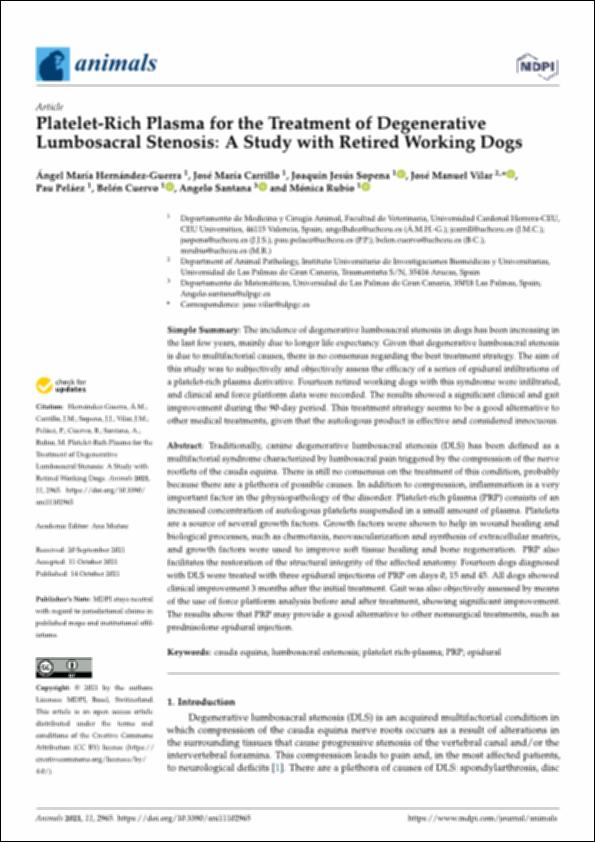Please use this identifier to cite or link to this item:
http://hdl.handle.net/10637/13494Platelet-rich plasma for the treatment of degenerative lumbosacral stenosis : a study with retired working dogs
| Title: | Platelet-rich plasma for the treatment of degenerative lumbosacral stenosis : a study with retired working dogs |
| Authors : | Hernández Guerra, Ángel María Carrillo Poveda, José María. Sopena Juncosa, Joaquín Jesús. Vilar, José M. Peláez Gorrea, Pau Cuervo Serrato, Belén Santana, Angelo Rubio Zaragoza, Mónica. |
| Keywords: | Cauda equina, Síndrome de - Tratamiento.; Growth factors - Therapeutic use.; Perros - Sistema nervioso - Enfermedades - Tratamiento.; Blood plasma - Therapeutic use.; Cauda equina syndrome - Treatment.; Dogs - Nervous system - Diseases - Treatment.; Plasma sanguíneo - Uso terapéutico.; Crecimiento - Factores - Uso terapéutico. |
| Publisher: | MDPI |
| Citation: | Hernández-Guerra, Á.M., Carrillo, J.M., Sopena, J.J., Vilar, J.M., Peláez, P., Cuervo, B., Santana, A. & Rubio, M. (2021). Platelet-rich plasma for the treatment of degenerative lumbosacral stenosis: a study with retired working dogs. Animals, vol. 11, i. 10 (14 oct.), art. 2965. DOI: https://doi.org/10.3390/ani11102965 |
| Abstract: | Traditionally, canine degenerative lumbosacral stenosis (DLS) has been defined as a multifactorial syndrome characterized by lumbosacral pain triggered by the compression of the nerve rootlets of the cauda equina. There is still no consensus on the treatment of this condition, probably because there are a plethora of possible causes. In addition to compression, inflammation is a very important factor in the physiopathology of the disorder. Platelet-rich plasma (PRP) consists of an increased concentration of autologous platelets suspended in a small amount of plasma. Platelets are a source of several growth factors. Growth factors were shown to help in wound healing and biological processes, such as chemotaxis, neovascularization and synthesis of extracellular matrix, and growth factors were used to improve soft tissue healing and bone regeneration. PRP also facilitates the restoration of the structural integrity of the affected anatomy. Fourteen dogs diagnosed with DLS were treated with three epidural injections of PRP on days 0, 15 and 45. All dogs showed clinical improvement 3 months after the initial treatment. Gait was also objectively assessed by means of the use of force platform analysis before and after treatment, showing significant improvement. The results show that PRP may provide a good alternative to other nonsurgical treatments, such as prednisolone epidural injection. |
| Description: | Este artículo se encuentra disponible en la siguiente URL: https://www.mdpi.com/2076-2615/11/10/2965 Este artículo pertenece al número especial "Monitoring of Fitness, Training Progression, and Responses to Rehabilitation Therapies in Veterinary Medicine". |
| URI: | http://hdl.handle.net/10637/13494 |
| Rights : | http://creativecommons.org/licenses/by/4.0/deed.es |
| ISSN: | 2076-2615 (Electrónico) |
| Issue Date: | 14-Oct-2021 |
| Center : | Universidad Cardenal Herrera-CEU |
| Appears in Collections: | Dpto. Medicina y Cirugía Animal |
Items in DSpace are protected by copyright, with all rights reserved, unless otherwise indicated.


